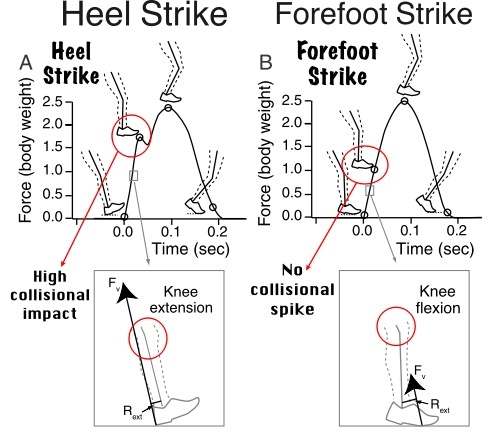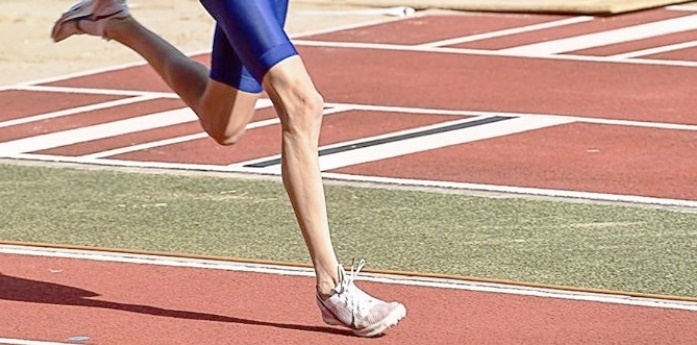Forefoot running was consistently found to be the best for your knees on the basis of it naturally improves the functional use of the knee joint in ways that for one. prevents knee injury and knee osteoarthritis, and for another, it leads to more efficient accelerations as compared with heel strike running, as shown below:

Numerous reports (references below article) concluded that less knee extension at toe-off (i.e. the beginning phase of flight) during running, the more beneficial to running economy as well.
- Less knee extension, and therefore, greater knee flexion and bend to initiate flight during running was found to contribute to more efficient propulsion with less muscle force (Moore et al.). This is because greater knee bend was found to optimize leg extensor-muscle function and muscle-tendon moments which are variables that are important in sustaining maximum propulsion production. In other words, forefoot running makes the most functional and safe use of the knee-joint that accounts for improved running economy because the muscles are less needed to thrust the body forward through each step.
According to emerging studies (references below article) on running economy and impact mechanics, your knees should never be fully straight, or hyper-extended during any phase of running because doing so forces your muscles to work harder to propel the entire body forward.
In a sense, you generate more propulsive power without having to do much work when your knees are slightly bent. Basically, keeping both knees slightly bent at all times injects a nice pop of spring in your stride, making running feel more effortless, while making the ground feel softer beneath your feet since the knee becomes better at deflecting impact when flexed, especially at landing, shown below:

Even better, keeping both knees bent during all phases of running prevents you from excessively bouncing up and down (i.e too much vertical oscillation). Equally important, ensuring both knees are kept slightly bent at all times when running was found to unburden the calves as muscle activation (muscular work) in the lower leg was reduced (Isabel, 2016)!
The Take Home Message
When it comes to safeguarding your knees in the best way that sustains, we have more empirical evidence about the progress you will make if you switch from heel strike to forefoot strike running, since to date, forefoot running is the only running style proven to improve the coordination of the knee joint by making the knee better at flexing and bending, and ultimately avoiding injury.

Still need more convincing? Here are over 30 evidence-backed reasons forefoot running is safer and more economical than heel strike running, regardless of footwear.
If you’ve enjoyed my post, you’ll love my YouTube channel, here, where I show why and how forefoot running is better by every measure.

References:
Moore, I. Is There an Economical Running Technique? A Review of Modifiable Biomechanical Factors Affecting Running Economy. Sports Med, 2016; 46:793-807.
Moore IS, Jones AM, Dixon SJ. Reduced oxygen cost of running is related to alignment of the resultant GRF and leg axis vector: a
pilot study. Scand J Med Sci Sports. 2015.

Bretta Riches
BSc Neurobiology; MSc Biomechanics candidate, ultra minimalist runner & founder of RunForefoot. I was a heel striker, always injured. I was inspired by the great Tirunesh Dibaba to try forefoot running. Now, I'm injury free. This is why I launched Run Forefoot, to advocate the health & performance benefits of forefoot running and to raise awareness on the dangers of heel striking, because the world needs to know.
Latest posts by Bretta Riches (see all)
- Heel Strike Running Causes Slipped Discs - 25/04/2024
- How to Train Yourself to Not Heel Strike When Running - 24/04/2024
- Cushioned Running Shoes Found to Be Bad for Ankles - 23/04/2024
